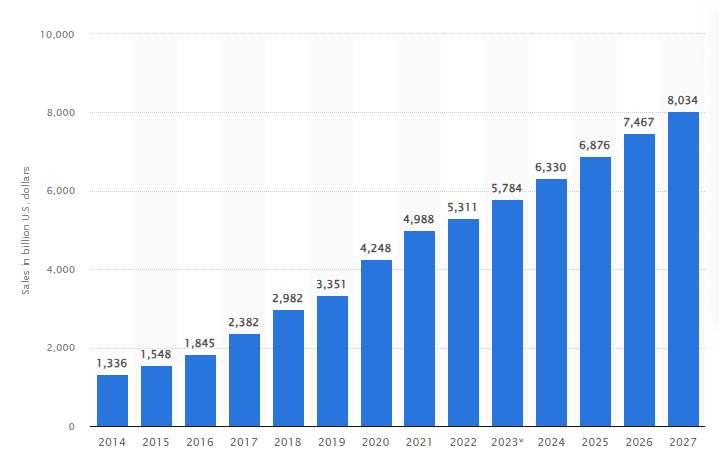Dropshipping is a popular business model that attracts many e-commerce beginners. It has low initial investments, and there is no need to hold inventory, which makes it alluring. However, many wonder if it’s truly profitable and what money they can make. Understanding the stages of a dropshipping business can provide a clearer picture of its potential.
In this article, we’ll explore the three stages of dropshipping and the profit you can expect at each stage. By the end, you’ll better understand the dropshipping journey and be better prepared to start your own venture. Whether you’re a beginner or looking to scale your business, this guide will offer valuable insights to help you succeed.
CONTENTS
Is Dropshipping Profitable?
Is dropshipping profitable? Yes, absolutely. Have you seen the stories of how some dropshippers source products from sites like AliExpress for $10 cheap and resell them for $50 or more, making thousands of dollars in profits each month? They are true.
Can you reach $ 100,000 in sales during the first year? Yes, it is possible. However, only 10-20% of dropshippers make it past the first year. Dropshipping is not a get-rich-quick scheme. It requires time, effort, and strategic planning. Profits might not be as great initially, but with persistence, optimization, and efficient marketing, your earnings will grow.
Success in dropshipping depends on various factors. One of the biggest draws of dropshipping is the low startup cost. Without the need to invest in inventory upfront, there is less financial risk, making it a great option for beginners to enter e-commerce. On the other hand, the competition is fierce, leading to lower profit margins. Still, there is plenty of room to earn – according to Statista, the number of people purchasing online is ever-increasing. Global eCommerce sales reached an estimated 5.8 trillion U.S. dollars in 2023 and are expected to exceed 6.3 trillion U.S. dollars in 2024. Projections indicate a 39% growth over the coming years, surpassing 8 trillion dollars by 2027.

Choosing the right products can significantly impact your profit margins. Typically, profit margins in dropshipping range from 15% to 60%, depending on the niche and competition. For example, high-demand, low-competition products tend to offer better margins.
Cost management is another important factor. While you don’t need to purchase inventory upfront, there are expenses like selling channel costs, transaction fees, taxes, marketing, and dropship automation tools. For instance, sellers on eBay may have higher fees but get substantial organic traffic for free, potentially reducing marketing costs. Shopify might have less fees, but you don’t get any traffic without marketing efforts. Plus, Shopify is famous for the vast number of apps you can install, which can substantially increase the monthly costs of running an online store. As you can see, effective cost management and pricing strategies are crucial to maintain profitability.
Moreover, success demands continuous optimization. This includes testing different products, trying marketing strategies, and providing excellent customer service all the time. By adapting to market changes and trends and continuously honing your skills, you can build a successful dropshipping business that can become your main source of income.
What Profit To Expect From Dropshipping Over 3 Stages?
Knowing the profit potential at different stages of your dropshipping journey is crucial for long-term success. Many entrepreneurs quit prematurely because they don’t understand the stages their business is going through. By breaking down the dropshipping journey into three phases, you can better assess your progress and set realistic expectations. Let’s explore these stages and the profits you can anticipate at each one.
1st Stage Of Dropshipping: Learning The Basics

The first stage is all about setting up your business and learning the basics. During this phase, you might and probably will incur some losses due to initial investments in selling channels and advertising. You’ll spend money on setting up your online store and investing in apps and tools to manage your operations.
Advertising costs are another significant expense at this stage. Running ads to attract customers is crucial, but it can be costly. Your expenses may outweigh your profits initially. However, if you grasp the basics well, you might start seeing small profits. Typically, beginners receive around 1-5 orders per day, depending on a niche and marketing efforts.
Benefits:
- Building a foundation for your business.
- Learning and adapting to the market.
- Gaining initial customer feedback to improve your offerings.
Challenges:
- Initial expenses with minimal profits.
- Steep learning curve.
- Potential discouragement due to slow profit growth.
This stage usually lasts 1 to 3 months, depending on how quickly you can learn from your experiences. Your monthly profits may range from breaking even to earning a few hundred dollars—this is normal for this time, so do not get discouraged.
Every successful dropshipper goes through a learning curve. This phase is about gaining experience, understanding your market, and refining your strategies. Keep in mind that these initial investments are laying the groundwork for the long-term success of your business. With persistence and continuous improvement, you’ll move on to the next stage, where you begin to see profits.
2nd Stage Of Dropshipping: Leveraging Your Knowledge

The second stage marks a significant milestone. You begin to leverage your knowledge gained during the first stage to increase profits and optimize operations. By now, you have a solid foundation and a better understanding of your market and customer preferences.
During this stage, your focus should be on expanding your advertising efforts and improving your store’s conversion rates. As you refine your marketing strategies and streamline operations, you can expect to see growth in both traffic and sales. This will lead to an increase in daily order volumes, typically ranging from 10 to 50 orders per day, depending on your niche and the effectiveness of your marketing efforts.
Benefits:
- Increased profitability as you optimize your business.
- Improved efficiency in managing ads and operations.
- Building brand credibility and customer trust.
Challenges:
- Balancing growth with maintaining customer service quality.
- Managing increased operational complexity.
- Dealing with competition and market saturation.
This stage can last anywhere from 6 months to a year or even longer, depending on your ability to manage growth and adapt to market changes. During this phase, monthly profits can range from a few thousand dollars to tens of thousands, reflecting your growth trajectory and market demand.
As you refine your strategies and expand your customer base, the second phase sets the direction for further growth and profitability.
3rd Stage Of Dropshipping: Scaling Your Business

The third stage of dropshipping is the mature phase. Your business becomes an established brand with consistent sales and a loyal customer base. By now, you’ve fine-tuned your strategies, optimized operations, and built a strong reputation in your niche. Next is scaling your operations and expanding your business.
In this phase, your focus shifts to maintaining steady profit margins and ensuring long-term profitability. With a solid customer base and reliable suppliers, you can expect consistent daily orders, often exceeding 50 per day. Your revenue streams become more predictable, allowing you to plan and invest confidently in future growth.
Benefits:
- Brand recognition and customer loyalty.
- Steady and predictable profit margins.
- Long-term sustainability and profitability.
Challenges:
- Continual innovation to stay ahead of competition.
- Managing a higher volume of orders and customer inquiries.
- Maintaining high standards of customer service and product quality.
At this stage, scaling your business further becomes a key objective. This might involve expanding into new markets, introducing new product lines, or increasing your advertising budget. Utilizing dropshipping automation tools is essential to handle the increased volume of orders efficiently. Automation streamlines inventory management, order processing, and customer service, freeing up your time to focus on strategic planning.
This stage can last indefinitely as long as you continue to adapt to market changes and meet customer needs. Monthly profits during this phase can be substantial, often reaching tens of thousands or more, depending on the size and scope of your business.
During the final stage, your business evolves into a thriving, long-term dropshipping venture. Your profits should be sufficient to turn this into a full-time job. At this point, you can hire VAs to manage tasks not covered by automation, allowing you to focus on other aspects of your life or start another business.
Frequently Asked Questions
Is Dropshipping Oversaturated In 2024?
While dropshipping is competitive, it is not oversaturated. Success depends on finding the right niche, effective marketing, and exceptional customer service.
What’s The Hardest Part Of Dropshipping?
The hardest part of dropshipping is identifying the right products, running effective marketing efforts, and providing exceptional customer service.
How Many People Fail Dropshipping? And How Many Succeed?
On average, between 10-20% of dropshippers make it past the first year of operations. A significant number of people fail due to unrealistic expectations and lack of perseverance. However, those who succeed typically do so by learning from their mistakes, continuously improving, and adapting to market trends.
Conclusion
Dropshipping can be profitable if you understand the different stages of growth and know what to expect at each phase.
Initially, you might face some losses as you set up your store and learn the basics. Persistence through this phase lays the groundwork for future success. The second stage increases profitability and growth as you refine your strategies and expand your operations. Finally, your business matures into an established brand with consistent sales and a loyal customer base, providing steady profits and long-term sustainability.
Success in dropshipping comes from continuous learning, adapting to market changes, and offering exceptional customer service. With dedication and strategic planning, you can overcome the challenges and enjoy the rewards of a successful business.

Hey, I’m Jeremy Clifford. I hold a bachelor’s degree in information systems, and I’m a certified network specialist. I worked for several internet providers in LA, San Francisco, Sacramento, and Seattle over the past 21 years.
I worked as a customer service operator, field technician, network engineer, and network specialist. During my career in networking, I’ve come across numerous modems, gateways, routers, and other networking hardware. I’ve installed network equipment, fixed it, designed and administrated networks, etc.
Networking is my passion, and I’m eager to share everything I know with you. On this website, you can read my modem and router reviews, as well as various how-to guides designed to help you solve your network problems. I want to liberate you from the fear that most users feel when they have to deal with modem and router settings.
My favorite free-time activities are gaming, movie-watching, and cooking. I also enjoy fishing, although I’m not good at it. What I’m good at is annoying David when we are fishing together. Apparently, you’re not supposed to talk or laugh while fishing – it scares the fishes.

